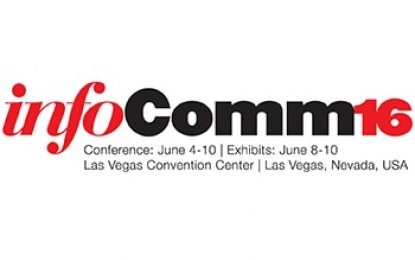InfoComm 2016: Where Venue Sound Struts Its Stuff
Story Highlights
 At a time when sonic quality and precision of coverage have become key metrics in the design of all sports venues, the InfoComm Show (Las Vegas Convention Center, June 8-10) is the place for showcasing sound systems. Besides doing business at the exhibit booths, many leading PA-system developers will set up scaled-down but still powerful versions of their flagship systems in large demo rooms at the convention center, all likely to flirt with the outer edges of the strict volume limits the show organizers impose. In the arms race that venue sound has become, the annual InfoComm Show and its nearly two dozen large demo spaces are the front lines.
At a time when sonic quality and precision of coverage have become key metrics in the design of all sports venues, the InfoComm Show (Las Vegas Convention Center, June 8-10) is the place for showcasing sound systems. Besides doing business at the exhibit booths, many leading PA-system developers will set up scaled-down but still powerful versions of their flagship systems in large demo rooms at the convention center, all likely to flirt with the outer edges of the strict volume limits the show organizers impose. In the arms race that venue sound has become, the annual InfoComm Show and its nearly two dozen large demo spaces are the front lines.
“For us, it’s the most important show of the year,” says Mike Hedden, president/CEO, Danley Sound Labs, whose point-source systems dominate large collegiate stadiums, such as Bryant-Denny Stadium at the University of Alabama and Tiger Stadium at LSU. “This show brings together the greatest number of [equipment] specifiers in one place. We sold a system to BYU here with a single 10-minute demo.”
InfoComm International is the trade association representing the professional audiovisual and information-communications industries. Historically, its main focus has been on training and certification, but, as A/V technology plays a growing part in venue design and performance — from museums to churches to sports stadiums and arenas — the importance of the organization’s annual tech expo has also increased. It has become the premier platform for presenting large-scale audio and video systems that simply don’t fit anywhere else, from sound systems that can stay hi-fi at 120 dB to video walls the size of aircraft hangars.
“InfoComm 2016 will be the largest pro-audio exposition held in the Western Hemisphere,” says Jason McGraw, SVP, expositions, InfoComm International. “With over 250 of the top commercial sound manufacturers showing their latest products and solutions for fixed installation and live events on the show floor, along with 20 audio demo rooms, InfoComm continues to deliver an incomparable pro-audio shopping and education experience that can’t be missed.
“High-performance, large-venue audio systems that enhance the attendees’ experience are table stakes for today’s competitive sports and live-performance venues,” he continues. “Major-league sports teams and touring productions demand the latest and greatest technologies that enhance the value of their events and support increasing event revenues. Attendees demand exceptional quality sound that they can clearly hear and feel. This rising demand is driving many investments in new pro-sound venue upgrades, new construction, and innovations from the audio manufacturers. It’s an exciting time for the industry.”
Practical Concerns
Audio-systems manufacturers view the InfoComm Show as a place to demonstrate how they can meet the practical demands that venues are facing. “Venue owners — colleges and cities — are looking at the systems they put into their stadiums and arenas more closely than ever before, because of costs,” observes Jeff Taylor, VP, Americas, for sound-system manufacturer VUE Audiotechnik. “Every venue now has to be used to its fullest extent, and a sound system has to [support] as much multifunctionality as possible.”
He notes that the system the company sold to the Bojangles Arena in Charlotte, NC, home to the AHL’s Charlotte Checkers, was chosen in part because it could be reconfigured to support local high school and university graduation ceremonies.
Taylor expects that theme to continue at this year’s event but also expects expanded convergence between A/V and IT, with sound systems moving further onto networks. “InfoComm is important for that,” he says, “because it can show the infrastructure that’s being built behind all of that.”
Danley President/CEO Mike Hedden agrees, adding, “It’s also fascinating to see the cross-pollination between audio and video now. And, as the video displays get bigger” — he cites the forthcoming Atlanta Falcons’ Mercedes-Benz Stadium’s Daktronics “halo,” 58 ft. high by 1,100 ft. in circumference, totaling 63,800 sq. ft. of LED video display that will ring the stadium’s opened retractable roof — “the audio has to keep up.” The new stadium will be fitted with a PA system using Danley Jericho horns.
That trend has put additional emphasis on low frequencies in stadium sound systems, because the bass aspect of music and effects has grown. That, in turn, has prompted InfoComm to adjust its metering of audio-demonstration volume levels to the “c-weighted” version of the decibel scale (dBC), which is used to measure sound in environments where the transmission of bass can be a problem, from the previously used “a-weighted” version (dBA), which effectively dismisses the lower and higher frequencies that the average person cannot hear from the analysis.
Hedden says he has built his one- to two-minute-long demo reels around those new metrics, looking to “stay legal” even as he shows off his systems’ horsepower.
“Sound in sports venues has to be loud,” he says, “but it also has to sound good” as well as meet increasingly stringent neighborhood noise-containment stipulations and other related concerns. “[Venue audio] has a lot more requirements to meet than before.”
